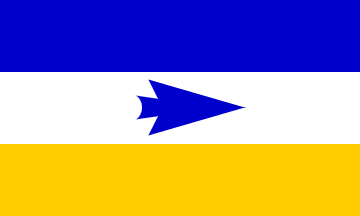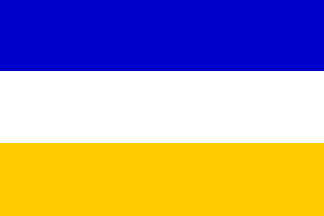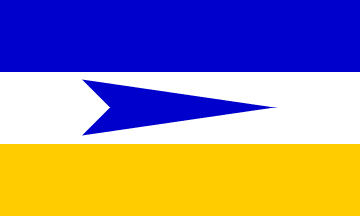
Last modified: 2012-04-06 by antónio martins
Keywords: tehuelche | patagonian | aónikenk | arrowhead (blue) | antieco (julio) | stick figure |
Links: FOTW homepage |
search |
disclaimer and copyright |
write us |
mirrors

It should be noted that the word "Tehuelche", itself
a Mapuche language word, may be spelled
"Tewelche" or "Tewelce" using the
more recent orthographic trends among Hispano-Amerindian circles. The actual
autonym is, in the near-extinct Tewelche language,
"Aónikenk".
António Martins, 17 Sep 2007
What is the nature of such an alliance? Perhaps a political and
cultural gathering, akin to those of Quechua and
Aymara, commonly opposing the dominant, spanish-descent culture?
According to ethnolinguistic
maps of Ethnologue.org, the Tehuelche live mainly in northeast
Santa Cruz province (AR), south of
Chubut and quite far away from the main
Mapuche populated areas, which are concentred
in Chile’s regions VII,
VIII, IX,
X and XI and in the
argentine province Neuquén. Still according to
Ethnologue.org, Mapuche and Tehuelche belong to distinct language
families (resp. Araucanian and Chon).
António Martins, 14 Jul 2004
Although Chubut and Neuquen
do not have a common border, they are very close. So the Mapuche from Neuquen
are close to northern Chubut. In the western part of Chubut there are both
Mapuche and Tehuelche.
Francisco Gregoric, 16 Jul 2004
On the question about this hybrid branding of this flag as
"Mapuche-Tehuelche", the English Wikipedia
articles at on Tehuelche
and Araucanization
give additional clues: Nowadays Tehuelche are recognized as such using only
non-linguistic traits, as their language is all but extinct (4 native speakers
as of 2006), having been replaced in the last ~100 years by Welsh, Spanish
and mostly Mapuche (the Araucanization process).
António Martins, 17 Sep 2007
Julio Antieco, one of the leaders of the native American communities had
the idea to have a flag to represent his people. The design was an idea from
him.
Francisco Gregoric, 16 Jul 2004
At the Endepa on line
almanach there is another reference to the adoption date of this flag:
«September 7th: creation of the Mapuche-Tehuelche flag
in Chubut», Chubut being in argentine Patagonia.
(Also mentioned in
ScorpionShops
website.)
António Martins, 14 Jul 2004
El Diario de Madryn [x9u07],
reports the celebration of the Flag Day by the
Mapuche-Tehuelche people and explains the origin of the
flag as follows. The flag of the Mapuche-Tehuelche was designed by Julio
Antieco, born on 19 July 1929. Antieco’s mother language is
Mapuche but he studied Spanish at school. He did his compulsary military
service in the the second battalion of Regiment 21 of the mountain infantery
of Bariloche; on 22 October 1950, he climbed the Lanin volcano with other
Argentine soldiers. Having realized that he had had no Mapuche symbol to stick
on the top of the mountain as required by the mountaineering tradition, Antieco
decided to consult his Mapuche brothers to design a flag. In 1987, the process
was started but not all Mapuche communities agreed to join it. The first
meeting took place in Trevelin and Antieco was commissioned to draft a flag
proposal. The flag uses the yellow and blue colours, the traditional colours
used in Mapuche camarucos (assemblies).
Ivan Sache, 15 Sep 2007
An article online as post 58th of blog
Winka
[x9u06],
yet another account of the origin of this flag, mostly in agreement with the
article from El Diario de Madryn
[x9u07]. On it there’s a photo showing
an exhibition panel labelled creacion_bandera
(direct
link; text unfortunately too small to read) with i.a. an image of
the flag in a very long ratio (some 1:20).
This article does not stress the warlike significance of the arrowhead
symbol (though its basic meaning is unmistakable).
António Martins, 17 Sep 2007
In Flag Report [frp] was published
in 1999 an statement of the Organización de comunidades
mapuche-tehuelche (Coordinadora
Mapuche-Tehuelche), that give the
meaning of the flag: the blue is for the upper “land”
with the forces of the air, wind, sun…; white mean snow, that is benefical
for the agriculture (after a winter wit snow, a summer with green pastures);
the yellow is for tehuelche land.
The arrow is because this people remain in
war until that obatin justice. This arrow will be expelled
from the flag when full rights are recognized to the Tehuelche.
Jaume Ollé, 22 Jul 2004
It is hard not to wonder
about any common trait between this flag and the
1810-1814 flag of Chile.
António Martins, 14 Jul 2004
I come across variations of the arrowhead shape itself, envolving different representations with a socket for the arrow shaft and other naturalistic additions; the color shades present almost no variation, not even the “difficult” dark yellow color, which doesn’t show as orange or some such:
The triband blue-white-yellow with an arrowhead is the Bandera de las
comunidades indígenas de la Provincia del Chubut (flag of the
indigenous communities of the Province of Chubut). Although the
idea of this flag was a “private one”
of the groups, nowadays this flag is an official flag in the (Argentine)
Province of Chubut. It is regulated by a provincial
law (no.4072 - 1995).
Francisco Gregoric, 16 Jul 2004

In Flag Report [frp] was published
in 1999 an statement of the Organización de comunidades
mapuche-tehuelche (Coordinadora Mapuche-Tehuelche), that this
arrow will be expelled from the flag when full rights are recognized to the
Tehuelche.
Jaume Ollé, 22 Jul 2004
Neither text (nor
El Diario de Madryn [x9u07]
nor Winka [x9u06]) mentions
the putative removal of the arrowhead as reported in
[frp], upon a sought independence of the
Tehelche people/territory.
António Martins, 17 Sep 2007
The design is certainly the same as the first
Chilean flag used before 1814. The reason why it is used by native
American groups is that apparently the design would have been used by some
native American tribes in late 19 Century. In those times the tribes used to
move freely from one side of the Andes to the other. It is possible that in
that moment, someone from Chile gave them the idea to use that historical
Chilean flag.
Francisco Gregoric, 16 Jul 2004
According to the article in El Diario de Madryn
[x9u07],
the middle white stripe is charged
with the transcription of the name of the people.
Ivan Sache, 15 Sep 2007
Is this supposed to be the arrowhead? I’m almost sure it
doesn’t, short of a writing system that spells "Tehuelche" /
"Patagonian" etc. as "➤" or "➙"
(which I never heard of). I could find on line no photographic evidence of a
version of this flag other than the naturalistic arrowhead,
namely of the one with writing on the white stripe as reported by
El Diario de Madryn.
[x9u07]
António Martins, 17 Sep 2007

The chart [tra01b] includes a
Mapuche-Tehuelche flag (thus captioned) which is a
strikingly modern looking triband of blue, white and golden with a blue
arrowhead on the middle stripe. It is credited «from a drawing
provided by Miguel Castillo-Bascary».
António Martins, 14 Jul 2004
In real flags the length of the arrowhead is shorter.
Francisco Gregoric, 16 Jul 2004
I could find on line no photographic evidence of a version of this flag
other than the naturalistic arrowhead, namely of the one
with highly stylized, long quadrangular arrowhead as depicted in Gustavo’s
chart [tra01b] and other secondary
sources).
António Martins, 17 Sep 2007
q!.gif)
Another Tehuelche symbol is used (without context of explanation) on
a
webpage about the Chubut province, along with
Welsh (draig) and
Mapuche (kultrun) symbols:
It is a dark blue square with a red shape made from square blocks, roughly
6×7 (red: (1,1)-(1,2), (1,6)-(1,7), (2,2)-(2,6), (3,4), (4,4), (5,1)-(5,7),
(6,1) and (6,7)). No flag use of this symbol known to me.
(Direct
image link, labelled
"SIMBOLO_TEHUELCHE").
António Martins, 17 Sep 2007

An interesting interview with an elder Mapuche lady includes flag references (my translation from Spanish):
We Tehuelche have a flag, which is white. There are reports about that flag in a cheiftain parlament in Genoa, Chubut, in 1869. Musters, an English explorer who was present, mentions it. In that parlament gathered the chieftains Casimiro, Orkeke, Hinchel and my grandfather Juan, according to Musters, in his book Life among the Patagonians; in that meeting it was decided that they would not ally with Calfucurá to attack Bahía Blanca.
As for the Tehuelche flag, we suppose that the motive of its adoption was that, been keen travellers, »the Tehuelche« found that a white flag granted them free pass and »thus« adopted it as their emblem; it is after all a symbol of peace and unity. We use it »hoisted« under the Argentine »national« flag.
António Martins, 14 Jul 2004 and 14 Nov 2004
This last paragraph seems to be a product of modern day wishful thinking:
Not only the described reaction to the truce flag contradicts the
reality of its usage (then and now, there and
everywhere), as also the adoption circumstances as described seems to
have a flaw of circular reasoning.
António Martins, 14 Nov 2004
An interesting interview with an elder Mapuche lady includes flag references (my translation from Spanish):
The Tehuelche (Patagonian) cheiftain Casimiro took with him everywhere the Argentine flag, it presided the »Mapuche« parliament sessions. »« The great Tehuelche chief Inacayal had a»n Argentine« national flag waving by the side of his tent, »« recieved as a gift from Perito Moreno to »the chief’s« son Utrac.
António Martins, 15 Jul 2004 and 14 Nov 2004
Anything below this line was not added by the editor of this page.